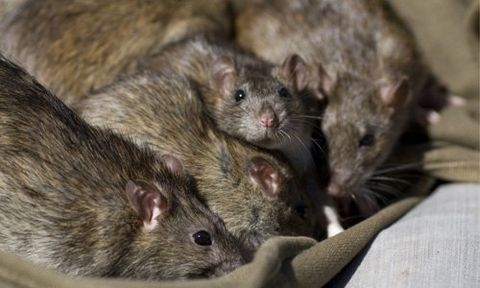Rat control for customers in Eastleigh, Southampton, Hampshire and Wiltshire
Are rats damaging your property? Put a stop to this problem by reaching out to our experts at Latham Pest Control today.
Contact us
Reliable rat control services
If your property is getting damaged and there are signs of rat debris around the property, it is time to get a reliable company to put an end to this. At Latham Pest ontrol, our team of experts will track down the root cause of a rat infestation. We have over 25 years of experience in providing quality rat control services to our customers in Eastleigh and Southampton. For more information, contact our team today.

How to get rid of rats
- Repair gaps in the doors. Broken air bricks and pet flaps will all allow them indoors
- Remove food source: Open bins and compost heaps
- Remove access to water sources: Dripping pipes

Professional pest control
Rats will come indoors in search of a cosy place to nest and a good supply of food. Rats have a few favourites like uncollected rubbish and litter, pet food that is left out and not eaten, fruits and berries that are fallen on the ground, untended compost and discarded food. You should ensure that rats have no access to food inside your property. Other than rat control, we also offer pest control, wasp control, ant control, mice control, bed bugs control, commercial contracts
and loft clearance.
What does a rat look like?
The best-known rat in the UK is the Norwegian or brown rat, Rattus norvegicus. The black or ship rat, Rattus rattus, is now rare in the UK.
A wild rat’s fur is usually brown, grey, or less commonly black.
Brown rats can measure up 25 centimetres, not including the tail. Males are generally larger than females, with average weights of 550 grams and 335 grams respectively.
Rats are capable of reproducing at six weeks old and can have up to five litters per year if conditions are suitable. The litter size can range from 6-14 young. The average lifespan of a wild rat is less than a year.
Rats are crepuscular, meaning that they are most active at twilight (dawn and dusk), although they can sometimes be seen during the day.
Why are rats so successful?
Because of the following amazing physical abilities, rats have survived hundreds of years in man’s environment:
Rats are excellent swimmers; they can swim up to half a mile in open water, travel through sewer line against strong currents and tread water for up to three days.
If rats can’t get around an object, they go through it. Rats are capable of gnawing through a variety of materials, including glass, lead sheathing and improperly cured concrete. A rat’s teeth grow continuously and are worn down by gnawing on hard surfaces and by working them against each other (known as bruxing).
Rats use hearing to locate objects to within a few inches, they have a frequency range of 50 kilohertz or more, which is much higher than humans who have a range of about 20 kilohertz.
Rats have poor vision beyond three or four feet, but they are very sensitive to motion up to 30-50 feet away. For the most part, rats are colour blind, but very light-coloured or reflective objects may stand out in their environment.
Rats have a highly developed sense of taste, which allows them to detect some chemicals at parts-per-million concentrations.
Smell is one of the rat’s most important senses. Rats mark objects and pathways to and from food sources,
Rats also have a highly developed sense of touch; this is due to very sensitive body hairs and whiskers (vibrissae), which they use to explore their environment.
Where do rats live?
Rats mainly exist in close contact with humans.
They tend to move to buildings in autumn and winter for shelter and food; they’re often found in warehouses, farms and roof spaces of houses. In summer they return to the open countryside to feed on growing vegetation.
If food is available all year round, rats will attempt to stay on site permanently.
Outside, their favourite haunts are:
- Under wood piles or lumber that is not being used often
- Under bushes and vines and in tall thick grass
- In and around rubbish that has been left out
- In holes or gaps under buildings
Once inside, they will happily live:
- Inside the insulation of walls and ceilings
- In or behind cupboards, counters and bathtubs
- Near your central heating or hot water boiler
- In basements or attics, where things like cardboard and cloth are stored
Brown rats' favour cereal, but being true omnivores they are known to eat almost anything. On average, a rat will consume 25-30 grams of food and drink approximately 60 millilitres of water per day.
When in the house, rats will eat anything not sealed in an airtight container, and even that is no guarantee. Rats have exceptionally powerful jaws and can eat most food stored in paper, plastic or cardboard containers.
What attracts rats?
Rats will come indoors searching for a cosy place to nest and a good supply of food.
Common favourites are:
- Uncollected rubbish and litter
- Food for pets and birds, left out and not eaten
- Fruit and berries that have fallen to the ground
- Untended compost heaps
- Dog droppings
- Discarded food
How do I know if I have a rat problem?
Rats are nocturnal creatures so it is very unlikely you will actually see them, so in order to spot them you need to look out for signs of their presence, such as:
- Droppings: dark droppings of amount 1cm in length
- Noises: rats make noise, especially at night time when they are awake, it’s usually a scratchy sound and will come from under the floorboards or in cavity walls.
- Odour: strong ammonia smell
- Teeth marks: rats need sustenance so check your kitchen for teeth marks in food or packets
- Nests: often found in warm and dark places and made of debris such as newspaper and fabric
- Holes: check for holes in decking, sheds and compost heaps
- Biting: rats chew on wood and plastic so look out for signs
Are rats harmful?
If they enter into the home wild rats may carry parasites and diseases that are harmful to humans and animals, including Leptospirosis (Weil’s disease, which can be fatal to humans), Salmonella, E.coli and Ringworm. Brown rats do not carry the plague.
Wild rats are more likely to try to escape than bite, so never try to approach one in a tight spot. A rat can inflict a lot of damage with its powerful jaws and sharp incisors. If you do get bitten then seek immediate medical advice, and be aware that you may need an injection against tetanus.
Another significant problem is the structural damage a rat can cause from gnawing and burrowing activities. This ranges from minor holes in walls/doors/furniture/cupboards to structural collapse, flooding, electrical faults and fire (due to gnawing through cables).
How to get rid of rats?
Understanding how to get rid of rats is not easy. They are ingenious, suspicious and generally move at night.
Like any other animal, they’re looking for sustenance and shelter. So, check in and around the shed, outbuildings or garages for signs of a nest; remove food sources, such as open bins, compost heaps with the wrong type of food in them and easy-to-get at food indoors – put anything they can access in sealable containers, and only buy squirrel-proof bird feeders; remove access to water, such as dripping pipes or pet bowls, and seal up access to the house – small gaps around doors, broken airbricks and pet flaps will all allow them indoors.
How Can Latham Pest Control help?
Latham Pest Control can provide highly targeted treatments to deal with any rat problems and will offer advice on how to keep your home free from rodents in the future.
